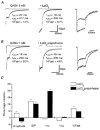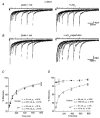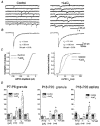Lanthanum-mediated modification of GABAA receptor deactivation, desensitization and inhibitory synaptic currents in rat cerebellar neurons
- PMID: 9714849
- PMCID: PMC2231154
- DOI: 10.1111/j.1469-7793.1998.647bg.x
Lanthanum-mediated modification of GABAA receptor deactivation, desensitization and inhibitory synaptic currents in rat cerebellar neurons
Abstract
1. We investigated La3+ effects on recombinant and native gamma-aminobutyric acid A (GABAA) receptors using rapid agonist applications and on inhibitory synaptic currents (IPSCs) in granule and stellate neurons of rat cerebellar slices. 2. Rapid desensitization of currents elicited by 200 ms pulses of 1 mM GABA to small lifted cells transfected with alpha1beta3gamma2 cDNAs was greatly decreased by the coapplication of 100 microM LaCl3. 3. GABA responses were unaffected when coapplication lasted only 2 ms. In contrast, with LaCl3 pre-perfusion, a significant slowing of deactivation in response to 2 ms applications was observed. LaCl3 pre-perfusion also prolonged the duration of responses to 20 mM taurine. 4. Outside-out patches excised from cells transfected with alpha1beta3gamma2 subunit cDNAs were briefly exposed to a saturating concentration of GABA, eliciting a transient activation of single channel currents with a main conductance of 30 pS. Opening and burst durations increased by pre-equilibration of patches with LaCl3. 5. LaCl3 depressed the peak amplitude without affecting the slow deactivation and desensitization of GABA responses in cells transfected with alpha6beta3gamma2 and alpha6beta3delta cDNAs. No significant difference in La3+ modulation of GABA-gated currents was observed between alpha1beta3gamma2 and alpha1beta3delta receptors. 6. The effects of LaCl3 on deactivation and desensitization of GABA responses observed in nucleated patches excised from rat cerebellar granule and stellate neurons were comparable to those in the cells transfected with alpha1beta3gamma2 cDNAs. In addition, La3+ clearly prolonged the spontaneous IPSC time course without changing the amplitude. 7. Our results indicate that La3+ has a dual action on GABA-gated currents: it decreases desensitization and increases channel opening duration. These actions depend on receptor subunit composition and contribute to the prolongation of IPSCs.
Figures








Similar articles
-
Pregnenolone sulfate modulates inhibitory synaptic transmission by enhancing GABA(A) receptor desensitization.J Neurosci. 2000 May 15;20(10):3571-9. doi: 10.1523/JNEUROSCI.20-10-03571.2000. J Neurosci. 2000. PMID: 10804198 Free PMC article.
-
Neurosteroid prolongs GABAA channel deactivation by altering kinetics of desensitized states.J Neurosci. 1997 Jun 1;17(11):4022-31. doi: 10.1523/JNEUROSCI.17-11-04022.1997. J Neurosci. 1997. PMID: 9151718 Free PMC article.
-
Frequency-dependent actions of benzodiazepines on GABAA receptors in cultured murine cerebellar granule cells.J Physiol. 1997 Sep 1;503 ( Pt 2)(Pt 2):353-69. doi: 10.1111/j.1469-7793.1997.353bh.x. J Physiol. 1997. PMID: 9306278 Free PMC article.
-
Bridging the cleft at GABA synapses in the brain.Trends Neurosci. 1994 Dec;17(12):517-25. doi: 10.1016/0166-2236(94)90155-4. Trends Neurosci. 1994. PMID: 7532336 Review.
-
Comparison of αβδ and αβγ GABAA receptors: Allosteric modulation and identification of subunit arrangement by site-selective general anesthetics.Pharmacol Res. 2018 Jul;133:289-300. doi: 10.1016/j.phrs.2017.12.031. Epub 2017 Dec 30. Pharmacol Res. 2018. PMID: 29294355 Free PMC article. Review.
Cited by
-
Methylmercury induces an initial increase in GABA-evoked currents in Xenopus oocytes expressing α1 and α6 subunit-containing GABAA receptors.Neurotoxicology. 2017 May;60:161-170. doi: 10.1016/j.neuro.2016.10.003. Epub 2016 Oct 6. Neurotoxicology. 2017. PMID: 27720918 Free PMC article.
-
Ethanol effects on GABA-gated current in a model of increased alpha4betadelta GABAA receptor expression depend on time course and preexposure to low concentrations of the drug.Alcohol. 2007 May;41(3):223-31. doi: 10.1016/j.alcohol.2007.04.007. Alcohol. 2007. PMID: 17591545 Free PMC article.
-
The Toxic Effect of Lanthanum on Planaria Is Mediated by a Variety of Ion Channels.Toxics. 2018 Jun 18;6(2):33. doi: 10.3390/toxics6020033. Toxics. 2018. PMID: 29912145 Free PMC article.
-
The general anesthetic propofol slows deactivation and desensitization of GABA(A) receptors.J Neurosci. 1999 Dec 15;19(24):10635-46. doi: 10.1523/JNEUROSCI.19-24-10635.1999. J Neurosci. 1999. PMID: 10594047 Free PMC article.
-
Phospholipase C-related inactive protein is involved in trafficking of gamma2 subunit-containing GABA(A) receptors to the cell surface.J Neurosci. 2007 Feb 14;27(7):1692-701. doi: 10.1523/JNEUROSCI.3155-06.2007. J Neurosci. 2007. PMID: 17301177 Free PMC article.
References
-
- Auger C, Marty A. Heterogeneity of functional synaptic parameters among single release sites. Neuron. 1997;19:139–150. 10.1016/S0896-6273(00)80354-2. - DOI - PubMed
-
- Copenhagen DR, Jahr CE. Release of endogenous excitatory amino acids from turtle photoreceptors. Nature. 1989;341:536–539. - PubMed
-
- Fritschy JM, Benke D, Mertens S, Oertel WH, Bachi T, Möhler H. Five subtypes of type A γ-aminobutyric acid receptors identified in neurons by double and triple immunofluorescence staining with subunit specific antibodies. Proceedings of the National Academy of Sciences of the USA. 1992;89:6726–6730. - PMC - PubMed
Publication types
MeSH terms
Substances
Grants and funding
LinkOut - more resources
Full Text Sources

